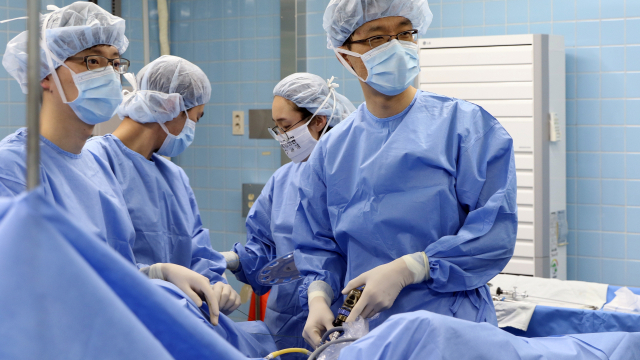<!–
“Quiet and mild” prostate cancer becomes “virulent” when metastasized to other organs
Entrance: 09-12-2022 18:17:31
<!–입력 : 2022-09-12 18:12:09수정 : 2022-09-12 18:17:20게재 : 2022-09-12 18:17:31–>
By Park Tae-woo, staff reporter [email protected]
–
–
90% or more can be cured if detected early
If it metastasizes to the bone, it will decrease by 50%.
The incidence is particularly high in men over the age of 50.
Regular check-up is required once a year even if there are no symptoms
Prostate cancer is often only discovered after the cancer has advanced to a very advanced stage. Professor Taek-Sang Kim of the Department of Urology is performing prostate cancer surgery. Provided by Kosin University Gospel Hospital
–
Prostate cancer, often referred to as “father’s cancer” because it affects men over the age of 50, is the fourth most common male cancer after lung, stomach and colorectal cancer. In Korea, the average annual increase is 13% due to the influence of Westernized eating habits and an aging population. Prostate cancer, which has no early symptoms and progresses slowly, is perceived as a “mild cancer” with a good prognosis, but once it has metastasized to other organs, the survival rate drops below 50%. As such, metastasis determines the survival rate of prostate cancer patients, so early diagnosis and prevention are important. To raise awareness of prostate cancer, the Korean Urological Association has designated September each year as Prostate Cancer Awareness Month and is running the “Blue Ribbon” campaign comparing it to the pink ribbon that symbolizes women’s breast cancer.
Half of the patients are found after stage 3
Following a survey conducted last year by the Korean Urology Foundation and the Korean Society of Urology and Oncology of prostate cancer patients, one in two Korean patients with prostate cancer (47.1%) said they had been diagnosed with advanced stage 3 or higher prostate cancer. Prostate cancer was detected when the cancer had already advanced outside the prostate or had metastasized to other organs.
This is because there are no noticeable symptoms in the early stages of prostate cancer. Professor Kim Taek-sang of the urology department at Kosin University Gospel Hospital said: “In the early stages of prostate cancer, there are no symptoms. Early prostate cancer usually develops a little further from the urethra, so symptoms such as difficulty urinating rarely appear, “he explained.
As prostate cancer gradually progresses, various symptoms of urination appear, such as not urinating well, a thin stem, and a feeling of residual urination. As you approach the terminal stage, you may experience pain as if your bones ring when you sit in a chair, which does not improve over time. Cancer cells can also invade the urethra or bladder, causing blood to leak into the urine.
Prostate cancer does not progress rapidly, but it metastasizes well to the bones or lymph nodes. Once it progresses to the bone, severe bone pain may require continued use of narcotic pain relievers, and the bone may weaken and fractures may occur. Also, spinal metastases are good, and in severe cases, lower body paralysis can occur.
If you are over 50, you should have regular checkups.
Prostate cancer is over 90% curable if detected early. According to 2018 cancer registry statistics, the 5-year relative survival rate (probability that cancer patients survive 5 years compared to the general population) when prostate cancer is a stage of local prostate cancer that does not leave the prostate is 102.6% and locally advanced prostate cancer outside the prostate In the case of, it was 98.6%. However, if the cancer progressed to a significant degree and metastasized to other organs, the survival rate dropped dramatically to 44.9%. For prostate cancer, early diagnosis and treatment are important, so it is important to pay attention to regular examinations from the age of 50, when the risk of onset increases rapidly.
Prostate cancer is usually diagnosed with abnormal results on the Prostate Cancer Marker (PSA) test. This is to determine the blood level of PSA, a tumor marker for prostate cancer, and can be known through a simple test from blood collected from a vein in the arm.
Professor Kim Taek-sang said: “If the PSA level is below 4.0 ng / mL, it is normal. If the PSA level is above 4.0, it is possible to suspect the development of prostate cancer and if it is 10 or more, the likelihood of prostate cancer is higher.
Although the cause of prostate cancer is not yet clearly known, old age, family history, obesity, and a high-fat diet are considered to be the main factors that increase risk. According to the current status of prostate cancer in Korea in 2017, the incidence of prostate cancer is higher in men with chronic diseases such as diabetes, hypertension and dyslipidemia than in normal men.
Professor Kim said: “About 10% of prostate cancer patients have a family history and if a father or sibling has prostate cancer, the incidence is three times that of the general public. you have a family history, it is good to undergo regular check-ups from the age of 40.
In the spotlight is robotic surgery which preserves the main functions
Prostate cancer is treated with surgery, radiation, hormone therapy, and chemotherapy. There are three types of surgery: laparotomy, laparoscopic surgery and da Vinci robotic surgery.
The advantages of robotic surgery are that there is little risk of bleeding or infection during the operation, urinary incontinence recovery is quick and sexual activity can be performed even after surgery because it does not touch the sexual nerves. As quality of life in old age becomes more important due to longer life expectancy, robotic surgery that preserves key functions is the focus of attention. However, the disadvantage is that the cost of the operation is relatively expensive compared to open surgery.
Those who have difficulty undergoing general anesthesia due to cardiovascular disease or stroke should be treated without resection, such as radiation therapy. This is the case in 20-30% of all prostate cancer patients. Nasal resection takes longer than surgery and has less therapeutic effect, but the latest technologies such as “high intensity ultrasound focusing (HIFU)” and “radioisotope implantation (brachytherapy)” have recently been introduced. and the treatment effect is good. HIFU uses high-intensity ultrasound to heat the prostate to eliminate cancer cells, and brachytherapy injects radioactive isotopes into the prostate evenly and gradually kills the cancer cells over a period of about a year.
Professor Kim said: “HIFU is a relatively simple procedure and has a similar therapeutic effect to laparotomy.
By Park Tae-woo, staff reporter [email protected]
–


